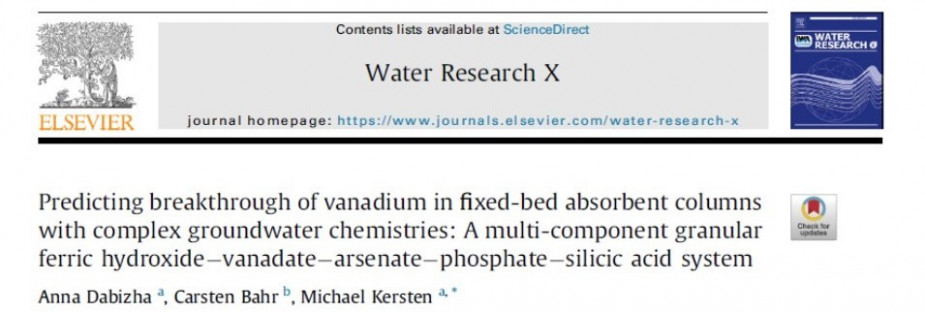Removing vanadium using GEH: scientific model published for predicting filter breakthroughs

When planning adsorption filters, the level of adsorption capacity that can be achieved plays a significant role, as this determines the lifetime (i.e. the replacement interval) and thus also the cost effectiveness. Practical experience has shown that the three target substances, arsenic, phosphorous and vanadium, exhibit a level of adsorption that is comparable with GEH, due to their chemical similarities. Silica, which frequently occur in water, can also influence adsorption. When these substances coincide, competitive adsorption results, thus diminishing the adsorption capacity compared to the actual target substance. Arriving at a model-based prediction for these competitive effects for real groundwater is a scientific challenge and of major practical significance.
In conjunction with the Hydrogeochemistry Work Group at the University of Mainz, a model for the multi-component granular ferric oxide - vanadate - arsenate - phosphate - silicic acid system has now been successfully created and tested on the basis of laboratory tests and practical data. By combining the Surface Complexation Model (CD-MUSIC) – to describe the adsorption equilibrium – with the Homogenous Surface Diffusion Model (HSDM) for the dynamic adsorption, characteristic breakthrough curves can be depicted, thus enabling the lifetime of GEH adsorption filters to be predicted. This is highly advantageous, especially for projects involving the removal of vanadium in drinking water, as this type of application is still relatively new and only limited practical data is available.
The findings have now been published in the international journal, WATER RESEARCH X, by Prof. Dr.-Ing. Michael Kersten, his staff member, Ms. Anna Dabizha (MSc), and our Head of R&D, Dr.-Ing. Carsten Bahr. Among other things, the findings revealed that vanadate adsorbs more strongly than arsenate or phosphate and that displacement effects can occur in the adsorption filter. The curve progressions of the vanadium breakthrough in the three GEH pilot adsorbers in waterworks situated in the Volcanic Eifel were successfully simulated using this new modelling approach.
The publication, titled “Predicting breakthrough of vanadium in fixed-bed absorbent columns with complex groundwater chemistries: A multi-component granular ferric hydroxide−vanadate−arsenate−phosphate−silicic acid system” is freely available (open access) and can be downloaded via the online database ScienceDirect owned and operated by the Elsevier publishing company: https://doi.org/10.1016/j.wroa.2020.100061
Further Links:
Hydrogeochemistry work group https://www.geowiss.uni-mainz.de/hydrogeochemie/
ResearchGate: https://www.researchgate.net/lab/R-D-Lab-of-GEH-Wasserchemie-GmbH-Co-KG-Carsten-Bahr


